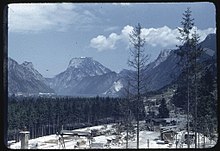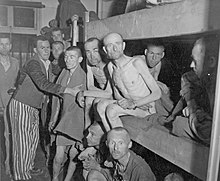Ebensee concentration camp
The Ebensee concentration camp was a satellite camp of the Mauthausen concentration camp in the municipality of Ebensee in Upper Austria .
The prisoners in the Ebensee concentration camp were used to drive tunnels and caverns into the mountain for the underground production of rockets.
History of the camp
The Ebensee sub-camp was built on Hitler's orders after the main production facilities for the V2 rockets had been destroyed by British air raids on the Peenemünde Army Research Center in the " Operation Hydra " night of August 17-18, 1943 . Hitler demanded from his armaments minister Speer that the production facilities should be relocated to underground tunnels (e.g. the tunnels in Kohnstein near Nordhausen ).
The production plant and other facilities should therefore be relocated from Peenemünde. In September, Kammler received the order for a tunnel system near Ebensee for the Peenemünde rocket development plant. The Armaments Council decided to have tunnels built on the Hochkogel and Erlakogel above the Traunsee . As with the tunnels near Nordhausen, thousands of concentration camp prisoners were to be employed as workers.
On November 8, 1943, the first prisoners were moved near the village of Ebensee to build prisoner barracks and workshop barracks. "Cement", "Kalksteinwerke", "Solvay", "Dachs II" or "Taube I" were chosen as cover names for these concentration camps. The prisoners had to drive the tunnels up to 250 meters into the mountain within a very short time. The entire tunnel system was connected to one another by a rail system.
However, since there were repeated delays in the work, the plan to relocate the rocket development plant from Peenemünde to the Alps was dropped in the summer of 1944. Instead, the Ministry of Armaments decided to use the underground facility in Ebensee for the production of Unit 9 (A9) as well as technical components for tanks and a refinery . At the end of 1944, the construction of the lubricating oil refinery began, which then began production in February 1945. In the spring of 1945, engines for tanks and airplanes were still being manufactured in plant B.
After the destruction of the station in Attnang-Puchheim on April 21, 1945, the so-called "death column" was transported to the station every day, partly by cattle wagon and partly on foot, in order to rebuild it.
In the period from November 1943 to May 1945, 8,745 prisoners died in the Ebensee concentration camp. At the end of April 1945 there were 18,437 prisoners in Ebensee. One day before the camp was liberated, on May 5, 1945, the camp commandant tried to drive the prisoners into the tunnels. However, they resisted so strongly that the camp commandant dropped the project.
Liberation of the camp
On May 6, 1945, Ebensee camp was liberated by soldiers from the 80th Infantry Division , a division of the 3rd US Army . Benjamin Ferencz observed how liberated prisoners beat up a concentration camp guard and burned him alive in the crematorium .
Post Liberation Story
After the liberation, a DP camp for Jewish so-called " Displaced Persons " was set up on the site of the concentration camp . Due to tensions between the Polish and Jewish camp residents, most of the Jewish DPs were relocated to Bad Gastein .
In 1947 Hilda Lepetit initiated and financed the construction of a monument based on a design by the Ebenseer architect Karl Winter. In 1950, the new concentration camp cemetery was built around the monument according to plans by Hans Foschum , architect and senior building officer of Upper Austria. State Building Directorate, created.
In 1990 a memorial was set up on a small part of the site, which contains the mass graves, the infirmary and the crematorium of the former concentration camp. The remaining area was built on with single-family houses over time, regardless of what happened. In 2001, this memorial was expanded to include the Ebensee Contemporary History Museum , which is located in Ebensee. There, the history of Austria and the region from 1918 to 1955 is dealt with. The documentation center also has the publicly accessible contemporary history library, which keeps victim and survivor databases, forced labor cards and contemporary documents such as photos. The sacrificial cemetery for deceased concentration camp prisoners is also located on the site.
There is also a deportation and resistance museum in the Italian twin town of Ebensees, Prato , from where many former prisoners come .
On May 9th, the memorial day for the victims of the Ebensee concentration camp takes place annually, on which survivors are also present. In 2009 there was an incident in which four young people shot at those present with airsoft weapons and chanted Hitler's cries. On December 1, 2010, three of those involved were sentenced to re-employment prison terms and were suspended on probation.
Camp life
The living conditions in Ebensee were worse than in most of the other sub-camps. Arriving prisoners were kept in quarantine for two weeks in order to break them mentally and physically. The many Italian prisoners who were deported to Italy after the general strike in March 1944 suffered in particular , as they were viewed by both Communist fellow prisoners as fascists and by the National Socialists as traitors. Out of 955 Italian prisoners, 512 died.
During the long winter from November 1943 to June 1944, when the last bits of snow disappeared, some of the prisoners had to stay barefoot because there weren't enough shoes. The prisoners were also more than inadequately dressed in other ways. In addition, they had to work 10 to 12 hours a day in the tunnels. Work in the tunnels was also ordered by the overseers as a measure of repression . Food rations were inadequate, the average daily ration was around 700 kcal .
The leading SS officer, Otto Riemer, was known as a drinker and sadist who enjoyed torturing and killing inmates. In addition, a man- trained mastiff "Lord" was kept in the camp and repeatedly tore inmates to pieces.
A Polish former prisoner, Ladislaus Zuk , lived in Ebensee until his death in 2016 and worked as a contemporary witness on guided tours.
Known inmates
- Roberto Castellani , Italian survivor of the Mauthausen and Ebensee concentration camps
- Curt Mezger
- Mario Piccioli , Italian survivor of the Mauthausen, Ebensee and Linz III concentration camps
- Italo Tibaldi , Italian survivor of the Mauthausen and Ebensee concentration camps
See also
literature
- Drahomír Bárta: Diary from the Ebensee concentration camp . Edited by Florian Freund and Verena Pawlowsky. Translated from the Czech by Mojmír Stránský. Turia + Kant, Vienna 2005, ISBN 3-85132-345-9 .
- Robert Bouchal, Johannes Sachslehner : Underground Austria - forgotten tunnels, secret projects. Styria , Vienna 2013, ISBN 978-3-222-13390-9 .
- Max R. Garcia: And if I survive Auschwitz ... My way from death to life. Edition Mauthausen , Vienna 2014, ISBN 978-3-902605-21-4 (Max R. Garcia was liberated from the Ebensee concentration camp on May 6, 1945 at the age of 21 and 40 kg).
- Florian Freund: The Ebensee concentration camp - rocket armor in the SS work camp "Zement". Studienverlag , Innsbruck 2006, ISBN 3-7065-4186-6 .
- Florian Freund: Die Toten von Ebensee - analysis and documentation of the prisoners who perished in the Ebensee concentration camp 1943–1945. Documentation archive of the Austrian resistance , Vienna 2010, ISBN 978-3-901142-57-4 .
Web links
- Ebensee concentration camp memorial and contemporary history museum
- Review of the 60th concentration camp liberation celebrations 05 and memories of former concentration camp prisoners. In: ebensee.at. Archived from the original on October 24, 2013 .
- Hans Kammler: Ebensee - code name "cement" "B1". In: Secret projects at. Archived from the original on March 7, 2011 .
- Contemporary history museum and Ebensee concentration camp memorial. In: Remember.at.
Movies
- Luci nel Buio (Lights in the Dark): Documentary 2003, directed by Gabriele Cecconi. Documentary film about the life of the Ebensee concentration camp prisoner Roberto Castellani .
Individual evidence
- ^ A b c Jens-Christian Wagner: Production of death: The Mittelbau-Dora concentration camp. Göttingen 2001, p. 87.
- ↑ Tom Agoston: Devil or Technocrat? - Hitler's gray eminence; SS General Hans Kammler. Nikol, Hamburg 1997, ISBN 3-930656-55-8 . P. 98
- ↑ Crash on the last day of the war: The secret of the P47 in the Traunsee. (mp4 video, 123 MB, 50:06 minutes) In: Spiegel TV . January 27, 2006, accessed on March 12, 2020 (interview from minute 28:40).
- ↑ Sebastian Gubernator: Nuremberg became his fate. In: Welt am Sonntag, October 7, 2018, p. 6.
- ↑ Wolfgang Quatember: The history of the Ebensee concentration camp memorial. (pdf, 240 kB) In: Remembering in memorials. Federal Ministry for Education and Cultural Affairs (Ed.), October 1998, pp. 28–30 , accessed on March 12, 2020 .
-
↑ Marcel Brecht: Visitors at a memorial ceremony shot at: imprisonment after neo-Nazi disturbance action in the Ebensee concentration camp. In: look to the right . December 3, 2010, archived from the original on February 14, 2011 ; accessed on March 12, 2020 . Decision on custody by tomorrow. In: derStandard.at . May 13, 2009, accessed March 12, 2020 .
- ↑ Andreas Schmoller: Missile armor and the "Project Cement". In: memorial-ebensee.at. Archived from the original on September 24, 2014 ; retrieved on March 12, 2020 : “In May 1944 he shot dead at least eight prisoners of a work detachment while drunk. When companies that had employed prisoners reported the incident to Mauthausen, Riemer was demoted. His successor, Anton Ganz, remained in command until the camp was liberated. His brutal behavior was strictly based on the rapid implementation of the armaments project and was closely related to the ruthless drive to work. "
- ^ Reports, quotations. In: antonkriegergasse.at. Archived from the original on October 24, 2013 ; accessed on March 12, 2020 (report from schoolchildren about an encounter with Ladislaus Zuk).
Coordinates: 47 ° 47 ′ 15 " N , 13 ° 45 ′ 28" E



